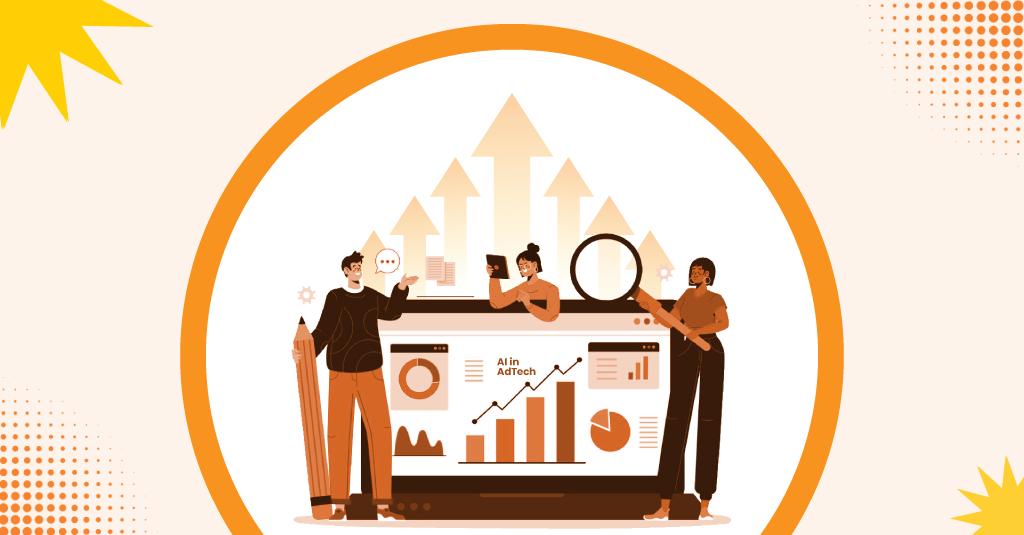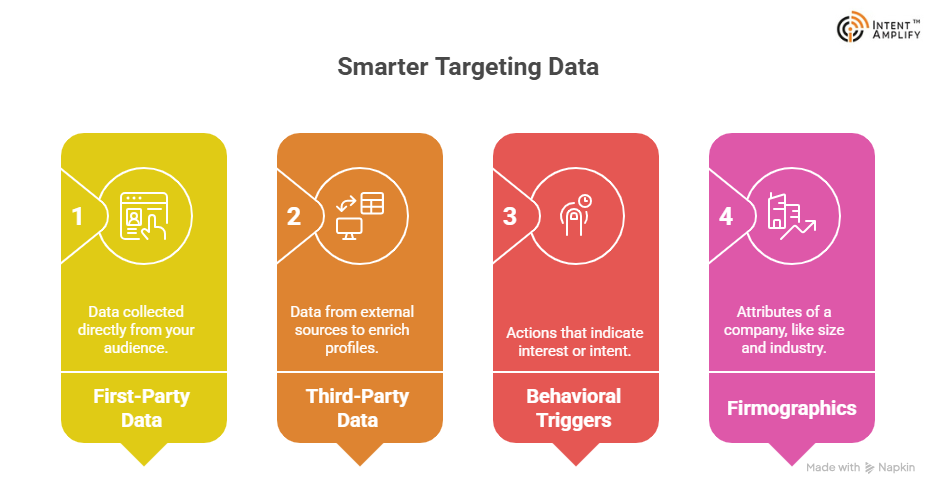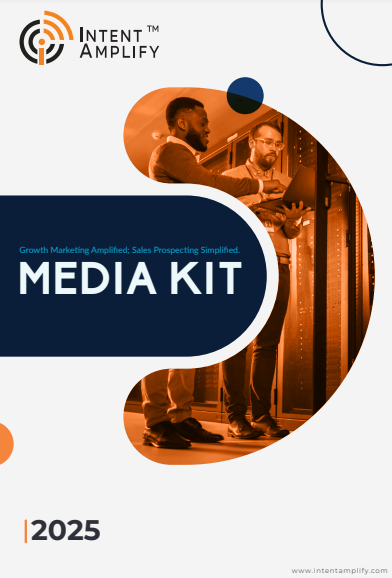
AI in AdTech for B2B: Smarter Targeting, Better Leads, Faster Pipeline
- Last updated on: July 28, 2025
AI in AdTech is transforming B2B marketing. B2B marketing has evolved into something quicker, wiser, and more accurate.
It’s not a trend, it’s a tectonic shift in how marketers find audiences, engage campaigns, and generate revenue. Artificial Intelligence now fuels the heart of AdTech platforms, allowing for deeper insights.
It is enabling more effective targeting and real-time optimization that traditional approaches just can’t keep up with. But this isn’t just flashy technology; it’s measurable performance. AI is empowering B2B marketers to shift from generic targeting and mass messaging to targeted engagement and quantifiable pipeline acceleration.
It’s not merely automation. It’s intelligence that learns in real time. AI platforms can analyze behavior, map intent, and anticipate what your best buyers will do next.
If your campaigns continue to depend on static audience lists, bid tweaks by hand, or generic creatives, you’re already behind. AI for AdTech delivers a superior route, one that enhances lead quality, boosts conversion, and fills the pipeline with velocity.
Real-World Case Studies: AI in B2B AdTech Execution
1. IBM Watson Advertising + Ad Council: AI-Powered Creative Optimization
Challenge:
The Ad Council required boosting engagement for its “Fight for Freedom” campaign, focusing on racial justice and social change. Classical creative testing was not quick or personalized enough to respond to changing audience dynamics.
Solution:
Collaborating with IBM Watson Advertising, the Ad Council employed the Accelerator AI platform to automatically generate creative versions, blending headlines, images, and CTAs, and test them in real time.
The platform continually learned which combinations appealed best to various audiences.
Results:
- 113% click‑through rate lift during the campaign
- 69% onsite action increase (site interaction, petition signing, etc.)
- 81 unique creative variations dynamically tested against benchmarking CTRs
This example highlights the ability of AI to execute programmatic creative optimization, real-time measurable lift driven by audience response signals.
2. Adobe Experience Platform + Forrester TEI Study: Real-Time Ad-Orchestration Cross-Channels
Challenge:
A B2B tech company included in Forrester’s Total Economic Impact™ study struggled with siloed ad delivery and fragmented buyer experiences. Paid campaigns were out of sync with email, web, and CRM channels.
Solution:
The team took advantage of the shared stack of Adobe Experience Platform, Journey Optimizer, and Real-Time CDP to map ad interactions anonymously to known customer identities. AI-powered orchestration initiated personalized responses for ad retargeting, email solicitation, and site personalization.
Results:
- 431% return on investment within under six months
- Payback of less than six months
- Increased cross-channel efficiency, resulting in more pipeline momentum
This illustrates how AI-driven ad behavior can do decisioning and integrate AdTech with more extensive martech to provide measurable revenue outcomes.
3. Salesforce Advertising Studio & Marketing Cloud: Clear Targeting through CRM-Based AI
Challenge:
B2B marketers required improved ad targeting, dynamically using CRM data to target known and lookalike audiences across channels. Client campaigns were plagued by duplicative messaging and inadequate personalization.
Solution:
With Salesforce Advertising Studio in conjunction with Salesforce Marketing Cloud, groups developed AI-powered target segments.
The software processed CRM and behavioral signals to construct lookalike audiences and automate ad delivery on platforms such as social and display networks.
Results:
- Improved accuracy of reaching target personas.
- Less wasted impressions and increased relevance.
- More alignment of ad spend and CRM-defined segments.
- Cloud Analysts.
This illustration highlights the way that AI in AdTech facilitates more intelligent audience targeting through the blending of first-party CRM data, behavioral intent, and automation, without dependence on legacy DMP configurations.
Why B2B AdTech Must Use AI Now
B2B marketing has never been the same as B2C.
B2B has longer sales cycles, more touch points, and bigger deal sizes. But now, even the most experienced marketers are under pressure.
Markets are saturated. Decision-makers are more difficult to reach. Budgets are under tighter scrutiny than ever before.
In addition to that, the purchasing process is broken. A lead may view an ad, sit through a webinar weeks later, grab a whitepaper months later, and request a demo only then.
These disjointed cues are difficult to tie together by themselves.
That’s where AI comes in.
AI doesn’t only automate mundane tasks. It alters the way we view the funnel. Afurther analyzes patterns that human teams can not catch. It bridges intent signals across platforms and learns and evolves alongside changing behaviors.
Here’s what it has to offer:
- Blow-by-blow data processing: AI can process millions of data points in real time—CRM updates, ad interactions, site behavior.
- Behavioral understanding: Algorithms identify patterns in how leads research, interact, and convert.
- Predictive decision-making: AI doesn’t inform you after the fact. It informs you about what will occur next.
- Scalable personalization: Messages, creatives, and timing adjust dynamically—no more manual segmentation.
In an area where timing and relevance reign supreme, this intelligence puts B2B marketers ahead of the pack. AI removes guesswork and allows teams to prioritize strategy, messaging, and revenue alignment.
Without AI, marketers operate on assumptions. With it, they operate on evidence.
Smarter Targeting: Moving Beyond Basic Segmentation
Targeting by job title and industry used to be enough. Not anymore. Today’s B2B buyers are more elusive.
They consume information across dozens of touchpoints, some visible, many not. Relying on outdated static lists means missing high-intent prospects who are actively exploring solutions but haven’t engaged directly.
AI changes are targeting from reactive to proactive.
With deep learning models, sites now process a rich blend of signals:
- First-party data: Form completions, site visits, email interactions
- Third-party data: Partner data, external intent signals, technographics
- Behavioral triggers: Frequency of engagement, repeat visitation, scroll depth
- Firmographics: Growth rate, revenue, vertical, company size
From these, AI constructs predictive audience models. These aren’t constructed on hypothesized personas; they are constructed from what they see.
Let’s take a real-life scenario:
AI can conclude that security managers of mid-sized healthcare companies, who’ve come to your product comparison page and clicked on price at least two times in the past 14 days, are 6 times more likely to convert during the quarter.
That’s accuracy. That’s a strength.
It doesn’t end there.
AI also optimizes lookalike audiences, not through static characteristics, but through real-time behavioral likeness. So your ad campaigns begin to target individuals who actually resemble your best customers.
And here’s the dividend: less wasted spending, shorter sales cycles, and greater conversion rates. Smarter targeting doesn’t just enhance metrics. It enhances results.
AI-Driven Lead Quality: Good Data, Good Conversations
You don’t require more leads. You require the proper ones.
That change, from quantity to quality, is where AI excels. B2B marketers struggle with lead quality most of the time. The forms arrive, but the sales teams lament the fit. Prospects become silent. Pipelines stall. It’s not only frustrating, it’s costly.
AI assists by serving as a filter and predictor.
First, it enriches leads with up-to-date firmographic and technographic information. Each lead is enriched with contextual data: company size, industry, tech stack.
That is, each record includes context, company size, industry, tech stack, funding rounds, and more.
Second, it dynamically scores leads. These scores aren’t based solely on form data, but on how leads act after they’ve converted:
- How many pages did they read?
- Did they revisit your site?
- Have they interacted with your competitors?
AI picks up on subtle behavior, such as a prospect viewing a product demo twice in 24 hours, and raises them to high priority. No rep would catch that at scale. AI does.
More sophisticated systems automatically pass leads based on close likelihood, territory, or account level. They also fire nurture streams specific to that lead’s activity.
It’s not simply efficient. It’s effective. Each conversation becomes more targeted, more intelligent, and more likely to convert.
Lead quality increases. Sales cycles get shorter. And marketing becomes closer to revenue.
Accelerating Pipeline with AI-Driven Automation (Extended)
Time is of the essence. Each stall in your pipeline is an opportunity lost.
In B2B, it’s not uncommon for leads to stay in the system for weeks, unscored, unassigned, unengaged. That’s not a tech issue. That’s a process issue. AI is fixing it.
AI automation impacts every aspect of the pipeline:
- Dynamic ad serving:
Ads adapt to behavior, segment, or even stage within a funnel. A person researching use cases views different creatives than one who’s already downloaded a whitepaper.
- Adaptive nurture paths:
Email journeys change in real time. If a prospect clicks, bypasses, or interacts with specific subjects, the sequence adapts accordingly without human action.
- Meeting scheduling assistants:
AI tools integrate with calendars and availability to suggest times in an instant, eliminating delays and manual coordination.
- Sales notifications:
If a lead shows purchasing behavior, like looking at prices or coming back to your site after 30 days, AI notifies the appropriate rep right away.
When you smartly automate, buyers receive what they require sooner. Reps respond sooner. Marketing synchronizes better. The whole pipeline runs smoother and advances with intention.
The outcome isn’t merely faster. It’s momentum.
Real-Time Optimization: Always-On, Always-Learning
Campaign optimization used to be reactive. You’d run a program, wait a few weeks, gather insights, and make changes. That lag time was costly.
Now, AI enables live course correction.
In a real-time environment, AI continuously tracks:
- Click-through rates
- Bounce rates
- Conversion velocity
- Time-on-page
- Segment performance by geography, industry, or buyer stage
When something underperforms, it’s adjusted. When something overperforms, it’s amplified. All without waiting for human intervention.
Let’s assume some individual creative is seeing its engagement drop. AI spots it, replaces it, and tests a variation. If a fresh audience segment begins to convert at an increased rate, AI sends more spend there, right now.
That kind of responsiveness wasn’t feasible a couple of years ago. Today, it’s table stakes.
Even small, incremental improvements, 1% gains here, 3% gains there, begin to compound over the long term. The aggregate effect can be enormous.
And while AI takes care of the mechanics, marketers can remain focused on strategy, story, and alignment with revenue objectives.
That’s the difference between momentum and management.
Integrating AdTech with CRM and Martech Systems
B2B teams don’t work in silos. Neither should your tech.
AI in AdTech is exponentially more effective when integrated across your stack—particularly with CRM and marketing automation platforms.
This integration empowers:
- Intent-to-journey alignment:
A lead who interacts with an ad is added to a segment in your marketing stack. They get personalized content, not generic nurture flows.
- CRM-guided targeting:
AI can view opportunity stages and send appropriate ads to drive deals forward. A deal that is held up in the proposal stage can prompt competitive differentiation content on LinkedIn.
- Revenue feedback loops:
Closed-won data is pushed back into targeting models, teaching them to identify similar high-converting leads.
This isn’t campaign optimization. It’s strategy alignment.
Sales, marketing, and ops share a common understanding of buyer behavior, from initial touch to last invoice. AI fills the gaps in data, bridges the gaps, and makes the system respond holistically.
In mature configurations, this can mean:
- Real-time retargeting based on CRM status.
- Triggered content based on sales discussions.
- Predictive deal scoring applied to marketing intensity adjustment.
When your stack talks, your strategy performs. And AI is the translator.
Conclusion
AI in AdTech isn’t a nicety, but rather a must-have for B2B marketing today.
The complexity of current buyer journeys, the need for accuracy, and the requirement to demonstrate ROI are compelling marketers to rethink. AI enables B2B teams to overcome outdated strategies: rigid segmentation, late optimization, and mass messaging.
What it provides in turn is actionable insight. Campaigns adjust. Targeting is refined. Lead quality is enhanced. And the pipeline flows quickly with less manual effort.
Technology, however, doesn’t close deals.
It requires strategy, discipline, and teamwork alignment. AI powers the engine, but marketers remain the drivers. Those who jump at this opportunity and figure out how to collaborate with AI will outrank and outshine.
The way ahead is clear. The outcome is quantifiable. Your next step is to make it happen.
FAQs
1. What is the ROI of investing in AI-based AdTech?
Based on research by Adobe and Forrester, businesses that utilize AI-based AdTech have reported returns of over 400%. ROI is achieved through quicker campaign cycles, savings of waste, and enhanced conversion efficiency.
2. Is AI in AdTech regulatory compliant under data privacy laws such as GDPR?
Yes, when done responsibly. Leading platforms utilize consent-based or anonymized data and align with privacy guidelines. It’s the marketers’ responsibility to monitor provider policies and practice ethics in data.
3. How does AI facilitate faster B2B sales pipelines?
AI eliminates bottlenecks by automating tasks, such as scoring, nurturing, scheduling, and retargeting. It makes the next step timely and relevant, keeping deals progressing.
4. Can AI in AdTech actually increase lead quality?
Yes. AI enriches leads with live data, scores them on likelihood to convert, and routes them more intelligently. This results in sales teams receiving more qualified leads and fewer dead ends.
5. How does AI enhance B2B audience targeting?
AI processes behavioral, firmographic, and intent signals in real time. Rather than static lists, it builds dynamic segments based on how prospects actually behave, resulting in higher match quality and lower wasted spend.




